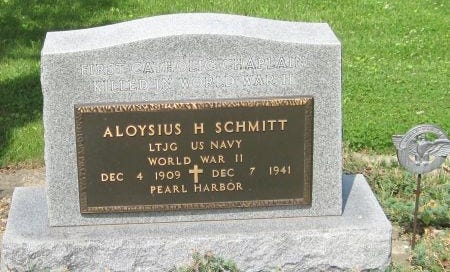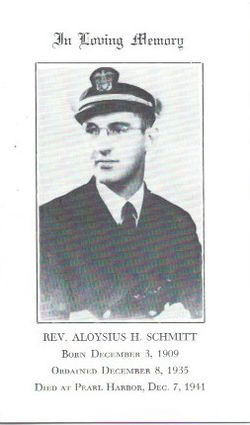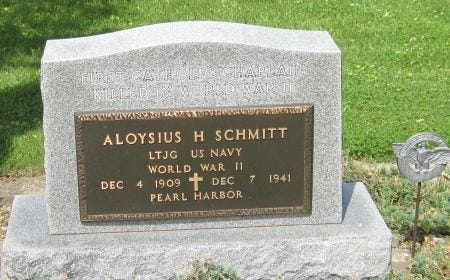He was the first Catholic chaplain to die in the war. And he died a hero.
St. Lucas, Iowa-native Father Aloysius Schmitt enlisted in the Navy Chaplain Corps in 1939 at age twenty-nine. He was among the 429 sailors who died aboard the battleship USS Oklahoma (BB-37) when Pearl Harbor was attacked on December 7, 1941.
Lt. j.g. Schmitt was known popularly as “Father Al.” I’ll summarize the story as fully told in Battlefield Chaplains: Catholic Priests in World War II by Donald F. Crosby, SJ (University of Kansas Press, 1994):
December 7, 1941, was a Sunday and Father Schmitt was in the ship’s recreation room preparing to celebrate Mass when the Oklahoma was torpedoed. The ship soon listed to twenty percent, and then thirty percent as tons of water crashed into the hold. Hundreds of men were trapped below the waterline. Father Schmitt and others reached a room that was dark, save a little light coming through a small porthole. The room was quickly filling with water as the ship began to list at a sickening angle. The porthole offered the only means of escape. Schmitt began pushing and shoving the men through the small opening. When all the men inside finally escaped, Schmitt asked them to pull him through - but he could not squeeze through, no matter how hard they pulled. “Boys, I’m having a tough time getting through,” one sailor recalled Schmitt saying. “You are endangering your lives,” he said. The men protested: “Chaplain, if you go back in there, you’ll never come out.” Schmitt’s reply was, “Please let go of me, and may God bless you all.”1
A year after his death the Navy awarded him the Navy and Marine Corps medal, citing his courageous efforts to save his men: “Calmly urging them on with a pronouncement of his blessing, he remained behind while they crawled out to safety … He gallantly gave up his life for his country.”2
Had he lived one more day he would have celebrated the sixth anniversary of his ordination.
Here is an extraordinary paragraph taken directly from Battlefield Chaplains:
Perhaps the most touching tributes came from the men who knew him best - the sailors, the officers, and his fellow chaplains. Several months after the attack on Pearl Harbor, a Jewish sailor spoke to a Protestant church audience in San Francisco and described how Schmitt had given up his life so that he might live. The audience listened intently, riveted by the story. In addition to a description of heroism, the young man’s address was also an example of ecumenism: A Protestant audience heard a Jewish sailor praising a Roman Catholic priest whose example had moved him profoundly on a day when he had almost lost his life. Indeed, one of the leitmotifs of World War II was a growing respect among Americans for the religion of others.3
More of Father Schmitt’s legacy:
The Navy commissioned a Buckley Class Destroyer, the USS Schmitt in 1943.
Awarded posthumously the Navy & Marine Corps Medal; The Silver Star (2017); Purple Heart.
Christ the King Chapel at Loras College (formerly Columbia College) was dedicated to his memory in 1947.
St. Francis Xavier Chapel at Camp LeJeune was dedicated in his memory in 1942.
Hs remains were originally buried in Hawaii, along with many others, as “Unknown.” As a result of the 2015 initiative undertaken by the Department of Defense to identify the remains of fallen personnel, Father Schmitt's were identified from DNA taken from his skull and matched with that of a relative.
Following the return of Father Al’s remains, a Mass of Remembrance was celebrated in his home parish of St. Luke in St. Lucas on October 5, 2016, followed by a funeral Mass with full military honors in Dubuque at Christ the King Chapel at his alma mater, Loras College (formerly Columbia College), on October 8, 2016. Interment was at St. Luke Cemetery.
A brief video from the 2016 Mass at Christ the King Chapel may be found here.
Requiescat in pace, Father Al.
Battlefield Chaplains, 8.
Ibid.
Ibid, 8-9.






A beautiful remembrance. Thank you, James.